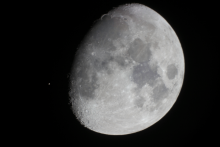Listen to today's episode of StarDate on the web the same day it airs in high-quality streaming audio without any extra ads or announcements. Choose a $8 one-month pass, or listen every day for a year for just $30.
You are here
Moon and Aldebaran
Our home galaxy, the Milky Way, contains hundreds of billions of stars. So no matter where you point a telescope, you’re going to see many of those stars. And they can appear so close to each other that it’s hard to tell if they’re related, or if they just happen to line up in the same direction.
Consider Aldebaran, the bright “eye” of Taurus, the bull. It’s close to the right of the Moon this evening, so you can’t miss it.
Over the centuries, astronomers have plotted five stars that appear quite close to Aldebaran. They’ve speculated that the stars are companions to Aldebaran — bound to the giant star by their mutual gravitational pull. Detailed observations, though, suggest that most of the stars aren’t related to Aldebaran at all — and perhaps none of them are.
It takes a while to figure out which stars are bound to each other. Astronomers track the motions of each star across the sky. Stars that are companions stick close together. But the motions can be quite subtle, so it can take decades to work them out.
And when stars appear especially close together, the problem is even tougher. One of the stars that’s close to Aldebaran may actually be a binary companion. But the star is quite small and faint, so its light is overwhelmed by Aldebaran’s. That makes it hard to measure the fainter star’s motion and distance. So despite decades of observation, no one is quite sure whether Aldebaran has a companion star — or moves through space alone.
Script by Damond Benningfield




